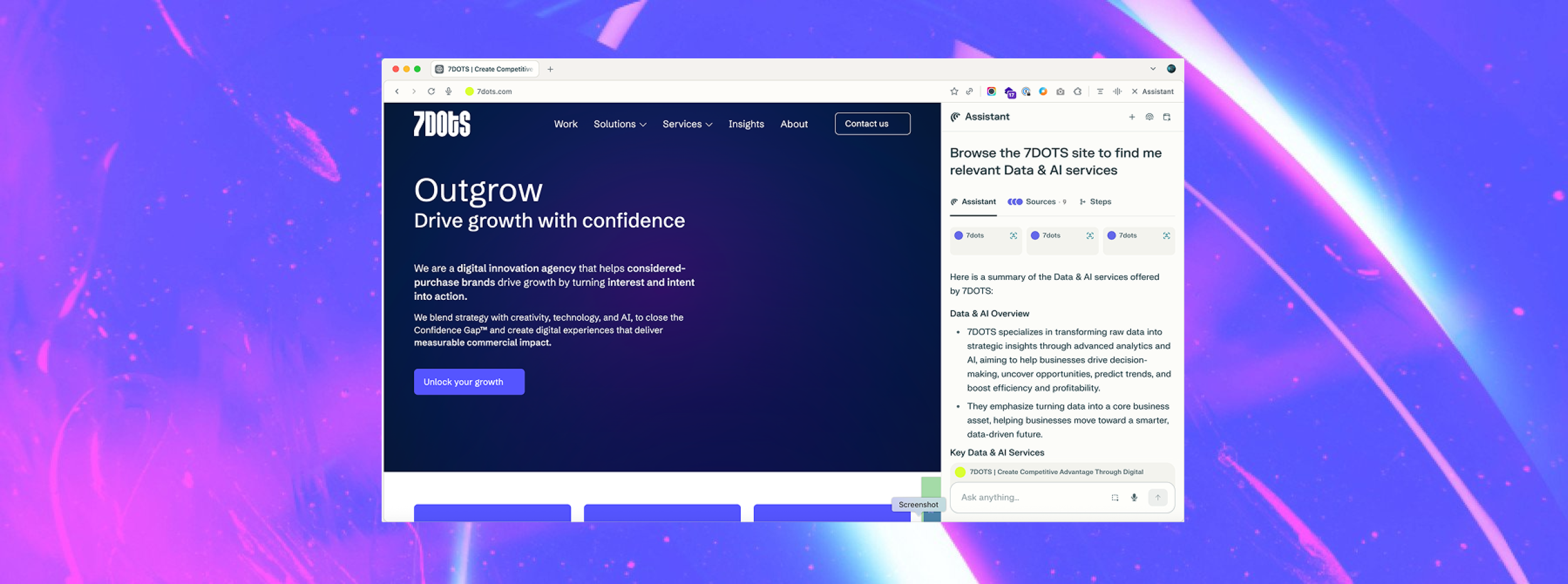Why Agentic AI matters
One of the questions we’re asked most often in our consulting work is: “What really is Agentic AI?”
At its simplest, agentic AI is the next step in how machines work alongside us. Instead of just responding to prompts, these systems can set goals, plan steps, and adapt when things change.
For brands in high-consideration purchase journeys, where customers spend weeks or months researching before they buy, this is going to be transformational.
Right now, the technology is still finding its feet. GPT-4, for example, only succeeds in 0.6 percent of complex travel planning tasks. But progress is rapid. McKinsey predicts agentic AI could unlock 11–18 trillion dollars of global economic value, on top of trillions more from generative AI.
The signal is clear: customer experiences won’t just be designed for people anymore. They’ll need to work for AI agents too.
What Agentic AI is
Think of it like this. A simple chatbot reacts to your question. An agent understands your goal, figures out the steps, uses the tools available, and executes on your behalf.
Some live examples today include:
COMET Browser, which can explore the web and make decisions independently
ChatGPT with agent capabilities, able to book meetings or pull structured data
LangChain and AutoGPT, which chain together reasoning steps and tools to achieve outcomes
This isn’t science fiction. It’s already happening.
Today’s limitations
The success rates today are low. On benchmarks like TravelPlanner, GPT-4 hits just 0.6 percent. Even on newer tests, fewer than one in ten itineraries match human-level quality.
But the trajectory matters more than the numbers. Early signs show us that these systems won’t stay niche. They’ll become mainstream far quicker than we expect.
A practical B2B example: Insurance research
Imagine you’re a mid-sized business looking at corporate insurance policies.
The old way: a manager spends days chasing brokers, reading through exclusions, and comparing documents.
With an agent: an AI assistant could take your requirements: industry, employee numbers, regulations, budget and then gather quotes, structure them in a comparable format, and present the top three options.
The human still makes the call, but all the legwork disappears. That’s the shift: agents do the admin, humans focus on judgment and relationships.
The business potential
The opportunity is huge:
McKinsey estimates agentic AI could add 11–18 trillion dollars to the global economy
Generative AI adds another 2.6–4.4 trillion in productivity
Yet only 1 percent of enterprises say they’re mature in AI adoption
Redesigning processes around agents could unlock productivity gains of 20–60 percent
The gap between potential and reality is enormous.
Designing for humans and agents
To stay ahead, brands need to build experiences that make sense to both people and machines. That means:
- Transparency and structure: make data clear and machine-readable, while still telling human stories
- Composable architecture: modular systems that agents can safely interact with
- Governance and trust: clear escalation and oversight
- Workflow redesign: agents orchestrate tasks, humans supervise
- Human-agent choreography: training teams to work alongside agents, focusing on judgment and creativity
This isn’t about replacing people. It’s about shifting the work so we spend less time on admin and more time on the things only humans can do.
What leaders should do now
- Shift your mindset: not “how do we add AI?” but “how do humans and agents work together?”
- Invest in agent-ready infrastructure.
- Start with high-impact areas—insurance research, supply-chain planning, customer onboarding.
- Build cross-functional teams across brand, data, tech, and operations.
- Measure impact beyond cost savings: look at agility, conversion, loyalty.
Why now, and why 7DOTS
Agentic AI is still clumsy. Soon, it will be reliable. Brands that start preparing now will be ready when it scales.
At 7DOTS, we believe customer journeys should be designed for both human intuition and agentic logic. This builds on our earlier perspective on “The Rise of Agentic Browsing,” and it’s where we’re helping brands prepare infrastructure and experiences for this dual audience.
If I’m honest, I don’t think this is optional. The shift is coming. The only choice is whether you’re ready for it.
Frequently Asked Questions about Agentic AI
What is Agentic AI?
AI systems that can set goals, plan tasks, use tools, and adapt to reach an outcome.
How is Agentic AI different to Generative AI?
Generative AI creates content, text, images, code, based on prompts. Agentic AI goes further. It uses generative AI as one of its building blocks, but adds reasoning, memory, and tool use so it can actually take action on your behalf. Think of generative AI as the engine, and agentic AI as the driver that decides where to go and how to get there.
What’s an example of Agentic AI in business?
Insurance research, where an agent gathers quotes, structures them, and recommends the best fit.
Why does Agentic AI matter for considered purchases?
These journeys involve complex comparisons and decisions. Agents can handle the data-heavy work so people can make better choices.
How mature is Agentic AI it today?
Still very early, with low success rates. GPT-4 was only successful 0.6% of the time. But progress is fast, and GPT-5 will already be better than this.
What value can Agentic AI it unlock?
Between 11 and 18 trillion dollars in global value, with significant productivity gains.
How should companies prepare for Agentic AI?
Structure data clearly, redesign workflows, build governance, and experiment with high-value use cases. Leaders need to take on a mindset around how they can use Agentic AI for advantage, rather than fearing it’s impact or on missing out.
Which industries will benefit most from Agentic AI?
Insurance, finance, healthcare, travel, automotive - anywhere decisions are complex and customers need confidence before buying.

